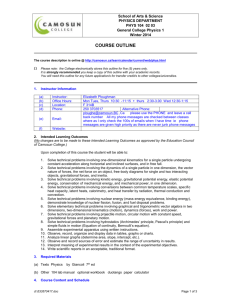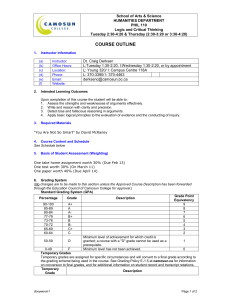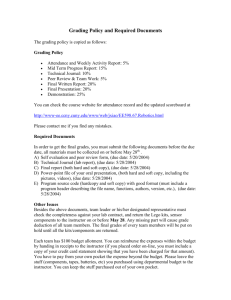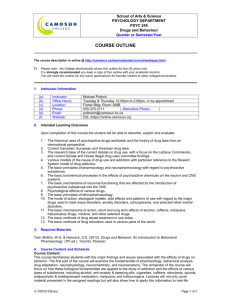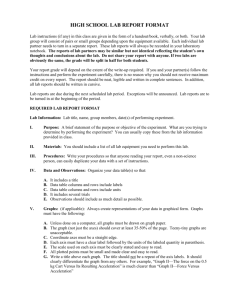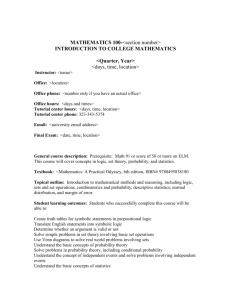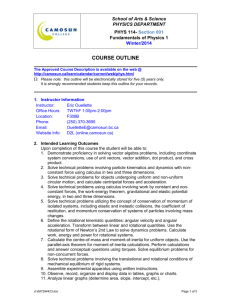PHYS-101-003 Nancy Luick
advertisement
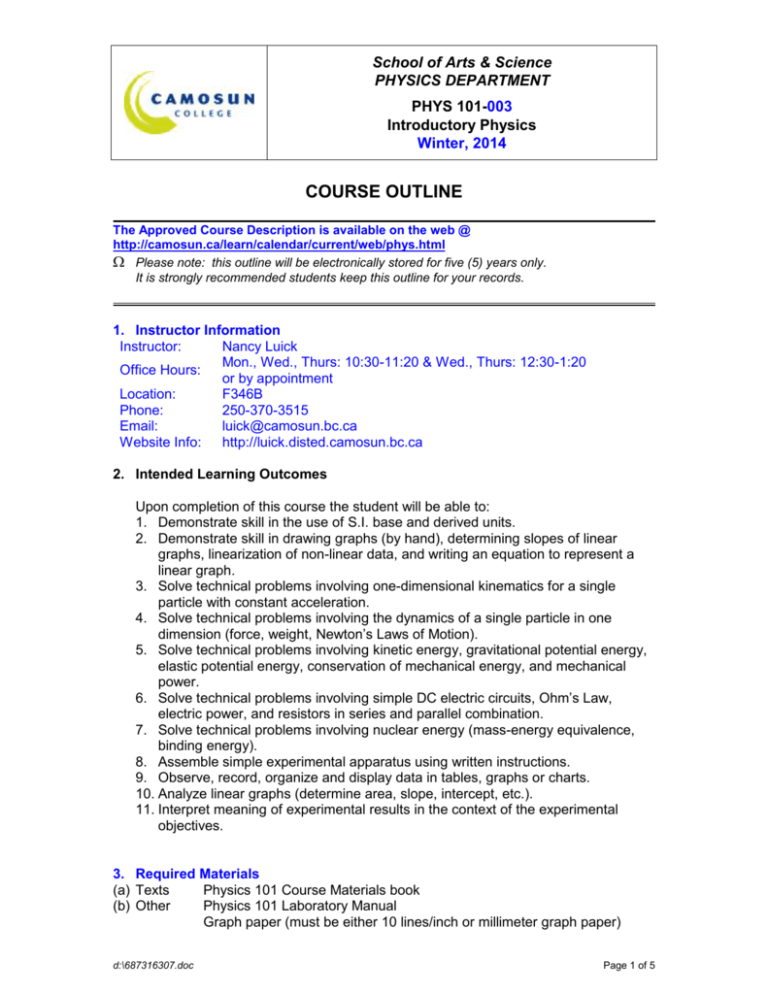
School of Arts & Science PHYSICS DEPARTMENT PHYS 101-003 Introductory Physics Winter, 2014 COURSE OUTLINE The Approved Course Description is available on the web @ http://camosun.ca/learn/calendar/current/web/phys.html Please note: this outline will be electronically stored for five (5) years only. It is strongly recommended students keep this outline for your records. 1. Instructor Information Instructor: Nancy Luick Mon., Wed., Thurs: 10:30-11:20 & Wed., Thurs: 12:30-1:20 Office Hours: or by appointment Location: F346B Phone: 250-370-3515 Email: luick@camosun.bc.ca Website Info: http://luick.disted.camosun.bc.ca 2. Intended Learning Outcomes Upon completion of this course the student will be able to: 1. Demonstrate skill in the use of S.I. base and derived units. 2. Demonstrate skill in drawing graphs (by hand), determining slopes of linear graphs, linearization of non-linear data, and writing an equation to represent a linear graph. 3. Solve technical problems involving one-dimensional kinematics for a single particle with constant acceleration. 4. Solve technical problems involving the dynamics of a single particle in one dimension (force, weight, Newton’s Laws of Motion). 5. Solve technical problems involving kinetic energy, gravitational potential energy, elastic potential energy, conservation of mechanical energy, and mechanical power. 6. Solve technical problems involving simple DC electric circuits, Ohm’s Law, electric power, and resistors in series and parallel combination. 7. Solve technical problems involving nuclear energy (mass-energy equivalence, binding energy). 8. Assemble simple experimental apparatus using written instructions. 9. Observe, record, organize and display data in tables, graphs or charts. 10. Analyze linear graphs (determine area, slope, intercept, etc.). 11. Interpret meaning of experimental results in the context of the experimental objectives. 3. Required Materials (a) Texts Physics 101 Course Materials book (b) Other Physics 101 Laboratory Manual Graph paper (must be either 10 lines/inch or millimeter graph paper) d:\687316307.doc Page 1 of 5 4. Course Content and Schedule Class Times: Mon. – Thurs. Lab Time: Friday 1:30-2:20 pm F316 12:30-2:20 pm F316 5. Basis of Student Assessment (Weighting) The student must be successful in both the theory and laboratory assignments to pass the course. The approximate percentages used for the final grading are: Tests Homework Lab Work Final Exam (3 hours) 35% 5% 10% 50% Refer to your instructor’s information for any additional comments regarding grading. PHYSICS DEPARTMENT POLICIES REGARDING TESTING: 1. The final exam will cover the entire course and will be 3 hours long. As stated in the current college calendar on page 39, “students are expected to write tests and final exams at the scheduled time and place.” Exceptions will only be considered due to emergency circumstances as outlined in the calendar. Holidays or scheduled flights are not considered to be emergencies. 2. Students must write quizzes, tests, midterm tests, etc., on the date and time assigned by the instructor. Missed exams normally receive a zero grade. Instructors are not required to provide make-up tests. At their discretion, instructors may waive a test in exceptional circumstances such as medical issues or a documented illness. 3. Refer to your instructor’s information page for any additional policies regarding testing and grade calculation. PHYSICS DEPARTMENT POLICIES REGARDING LABS: 1. All assigned laboratory exercises and reports must be completed and handed in prior to the date of the final exam with an overall grade of 60% in order to obtain credit for the course. 2. Attendance is mandatory & you may be required to “sign in” at the beginning of each lab period. A lab may be waived or made up at a later time only in the case of documented illness or other extenuating circumstances. If you will be absent from a lab period due to illness it is your responsibility to notify your instructor. 3. Unless otherwise stated by your instructor late penalties are as follows: For overdue labs (or assignments), a late penalty of 1 mark per day (10%) will be assessed for the first five days following the due date. After this date a complete report is still required and earns a maximum mark of 50%. Late assignments will not be accepted after solutions have been posted to website – normally 2 or 3 working days after due date. 4. At the discretion of the instructor, a student who is repeating this Physics course may apply for lab exemption. d:\687316307.doc Page 2 of 5 6. Grading System Standard Grading System (GPA) Percentage Grade 90-100 85-89 80-84 77-79 73-76 70-72 65-69 60-64 A+ A AB+ B BC+ C 50-59 D 0-49 F Description Grade Point Equivalency 9 8 7 6 5 4 3 2 Minimum level of achievement for which credit is granted; a course with a "D" grade cannot be used as a prerequisite. Minimum level has not been achieved. 1 0 Temporary Grades Temporary grades are assigned for specific circumstances and will convert to a final grade according to the grading scheme being used in the course. See Grading Policy E-1.5 at camosun.ca for information on conversion to final grades, and for additional information on student record and transcript notations. Temporary Description Grade Incomplete: A temporary grade assigned when the requirements of a course have not yet been completed due to hardship or extenuating I circumstances, such as illness or death in the family. In progress: A temporary grade assigned for courses that, due to design may require a further enrollment in the same course. No more than two IP grades will be assigned for the same course. (For these IP courses a final grade will be assigned to either the 3rd course attempt or at the point of course completion.) Compulsory Withdrawal: A temporary grade assigned by a Dean when an instructor, after documenting the prescriptive strategies applied and consulting with peers, deems that a student is unsafe to CW self or others and must be removed from the lab, practicum, worksite, or field placement. 7. Recommended Materials or Services to Assist Students to Succeed STUDY TIME It is recommended that between 5 and 10 hours per week (or more for students with a weak background) be spent studying for this course outside of class time. LEARNING SUPPORT AND SERVICES FOR STUDENTS There are a variety of services available for students to assist them throughout their learning. This information is available in the College calendar, at Student Services or the College web site at camosun.ca. STUDENT CONDUCT POLICY There is a Student Conduct Policy which includes plagiarism. It is the student’s responsibility to become familiar with the content of this policy. The policy is available in each School Administration Office, at Student Services and on the College web site in the Policy Section.www.camosun.bc.ca/divisions/pres/policy/2-education/2-5.html d:\687316307.doc Page 3 of 5 OUTLINE: 1. Measurement & Units 1.1 Concepts of physics 1.2 Accuracy and precision 1.3 Significant figures 1.4 Scientific notation 1.5 Systeme Internationale (SI) 1.5.1 Base units 1.5.2 Prefixes 1.5.3 Derived units 1.6 Conversion of units 1.7 Problem solving 2. Graphical Analysis 2.1 Graph construction 2.1.1 Plotting data 2.1.2 Fitting curves to data 2.2 Analyzing linear graphs 2.2.1 Determination of slope and intercept 2.2.2 The linear equation 2.3 Analyzing non-linear graphs 2.3.1 Recognition of power graphs 2.3.2 Changing variables to produce linear graphs 2.3.3 Writing equations for non-linear graphs 3. Kinematics in One Dimension 3.1 Kinematic quantities 3.1.1 Vector and scalar quantities 3.1.2 Position, distance and displacement 3.1.3 Average speed and velocity 3.1.4 Acceleration 3.2 Kinematic graphs 3.2.1 Position versus time 3.2.2 Displacement versus time 3.2.3 Velocity versus time 3.3 Equations of uniformly accelerated motion 3.3.1 Solving kinematic problems 3.3.2 Acceleration due to gravity 3.3.3 Vertical motion near the Earth 4. Dynamics in One Dimension 4.1 Concept of force 4.2 Newton’s first law of motion 4.2.1 Concept of inertia 4.3 Newton’s second law of motion 4.3.1 Dependence of acceleration on net force 4.3.2 Dependence of acceleration on mass 4.3.3 Dependence of net force on mass 4.4 Newton’s third law of motion 4.4.1 Interpretation of examples of the law d:\687316307.doc Page 4 of 5 5. Work, Energy and Power 5.1 Work 5.1.1 Definition 5.1.2 Calculating work done by a force 5.1.3 Positive and negative work 5.2 Types of Mechanical Energy 5.2.1 Kinetic energy 5.2.2 Gravitational potential energy 5.2.3 Elastic potential energy 5.3 Work-Energy Theorem 5.4 Conservation of Mechanical Energy 5.5 Power and Efficiency 6. Electrical Energy 6.1 Laws of Electrostatics 6.1.1 Atomic structure 6.1.2 Conductors and insulators 6.2 Electric circuits 6.2.1 Definitions of current, voltage and resistance 6.2.2 Basic circuit elements 6.2.3 Ohm’s law 6.2.4 Electrical energy and power 6.2.5 Characteristics of series circuits 6.2.6 Characteristics of parallel circuits 7. Nuclear Energy 7.1 The nucleus 7.1.1 Characteristics of the atom 7.2 Mass-Energy 7.2.1 Equivalence of mass and energy 7.2.2 Mass defect in nucleus 7.2.3 Binding energy 7.3 Nuclear energy 7.3.1 Fission and fusion 7.3.2 Chain reactions 7.3.3 Safety concerns d:\687316307.doc Page 5 of 5
